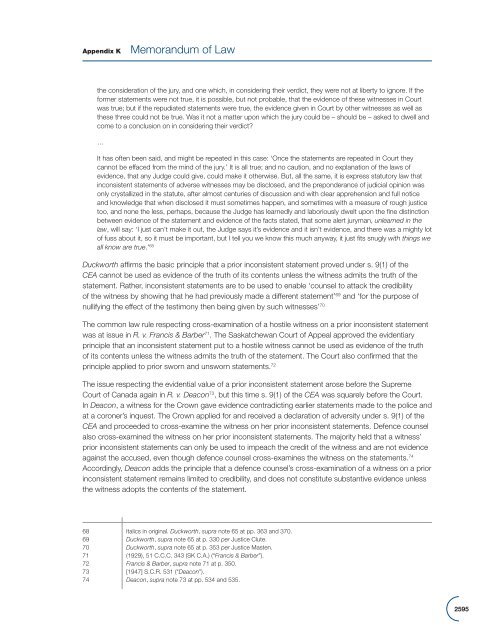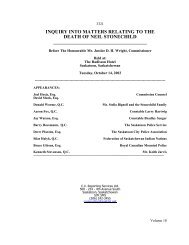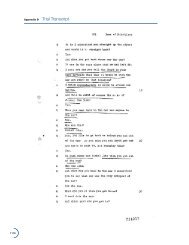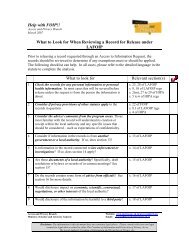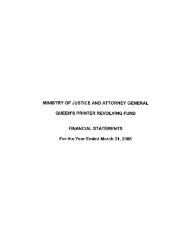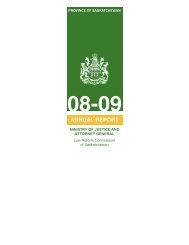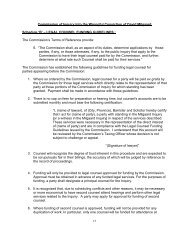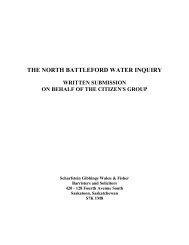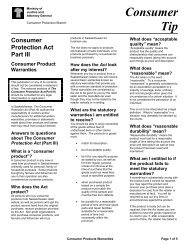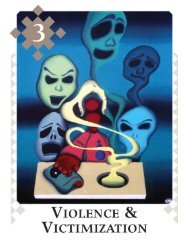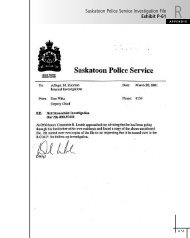Appendix K Memorandum of Law - s. 9(2) of the Canada Evidence Act
Appendix K Memorandum of Law - s. 9(2) of the Canada Evidence Act
Appendix K Memorandum of Law - s. 9(2) of the Canada Evidence Act
Create successful ePaper yourself
Turn your PDF publications into a flip-book with our unique Google optimized e-Paper software.
<strong>Appendix</strong> K <strong>Memorandum</strong> <strong>of</strong> <strong>Law</strong><br />
<strong>the</strong> consideration <strong>of</strong> <strong>the</strong> jury, and one which, in considering <strong>the</strong>ir verdict, <strong>the</strong>y were not at liberty to ignore. If <strong>the</strong><br />
former statements were not true, it is possible, but not probable, that <strong>the</strong> evidence <strong>of</strong> <strong>the</strong>se witnesses in Court<br />
was true; but if <strong>the</strong> repudiated statements were true, <strong>the</strong> evidence given in Court by o<strong>the</strong>r witnesses as well as<br />
<strong>the</strong>se three could not be true. Was it not a matter upon which <strong>the</strong> jury could be – should be – asked to dwell and<br />
come to a conclusion on in considering <strong>the</strong>ir verdict?<br />
…<br />
It has <strong>of</strong>ten been said, and might be repeated in this case: ‘Once <strong>the</strong> statements are repeated in Court <strong>the</strong>y<br />
cannot be effaced from <strong>the</strong> mind <strong>of</strong> <strong>the</strong> jury.’ It is all true; and no caution, and no explanation <strong>of</strong> <strong>the</strong> laws <strong>of</strong><br />
evidence, that any Judge could give, could make it o<strong>the</strong>rwise. But, all <strong>the</strong> same, it is express statutory law that<br />
inconsistent statements <strong>of</strong> adverse witnesses may be disclosed, and <strong>the</strong> preponderance <strong>of</strong> judicial opinion was<br />
only crystallized in <strong>the</strong> statute, after almost centuries <strong>of</strong> discussion and with clear apprehension and full notice<br />
and knowledge that when disclosed it must sometimes happen, and sometimes with a measure <strong>of</strong> rough justice<br />
too, and none <strong>the</strong> less, perhaps, because <strong>the</strong> Judge has learnedly and laboriously dwelt upon <strong>the</strong> fine distinction<br />
between evidence <strong>of</strong> <strong>the</strong> statement and evidence <strong>of</strong> <strong>the</strong> facts stated, that some alert juryman, unlearned in <strong>the</strong><br />
law, will say: ‘I just can’t make it out, <strong>the</strong> Judge says it’s evidence and it isn’t evidence, and <strong>the</strong>re was a mighty lot<br />
<strong>of</strong> fuss about it, so it must be important, but I tell you we know this much anyway, it just fits snugly with things we<br />
all know are true.’ 68<br />
Duckworth affirms <strong>the</strong> basic principle that a prior inconsistent statement proved under s. 9(1) <strong>of</strong> <strong>the</strong><br />
CEA cannot be used as evidence <strong>of</strong> <strong>the</strong> truth <strong>of</strong> its contents unless <strong>the</strong> witness admits <strong>the</strong> truth <strong>of</strong> <strong>the</strong><br />
statement. Ra<strong>the</strong>r, inconsistent statements are to be used to enable ‘counsel to attack <strong>the</strong> credibility<br />
<strong>of</strong> <strong>the</strong> witness by showing that he had previously made a different statement’ 69 and ‘for <strong>the</strong> purpose <strong>of</strong><br />
nullifying <strong>the</strong> effect <strong>of</strong> <strong>the</strong> testimony <strong>the</strong>n being given by such witnesses’ 70<br />
The common law rule respecting cross-examination <strong>of</strong> a hostile witness on a prior inconsistent statement<br />
was at issue in R. v. Francis & Barber 71 . The Saskatchewan Court <strong>of</strong> Appeal approved <strong>the</strong> evidentiary<br />
principle that an inconsistent statement put to a hostile witness cannot be used as evidence <strong>of</strong> <strong>the</strong> truth<br />
<strong>of</strong> its contents unless <strong>the</strong> witness admits <strong>the</strong> truth <strong>of</strong> <strong>the</strong> statement. The Court also confirmed that <strong>the</strong><br />
principle applied to prior sworn and unsworn statements. 72<br />
The issue respecting <strong>the</strong> evidential value <strong>of</strong> a prior inconsistent statement arose before <strong>the</strong> Supreme<br />
Court <strong>of</strong> <strong>Canada</strong> again in R. v. Deacon 73 , but this time s. 9(1) <strong>of</strong> <strong>the</strong> CEA was squarely before <strong>the</strong> Court.<br />
In Deacon, a witness for <strong>the</strong> Crown gave evidence contradicting earlier statements made to <strong>the</strong> police and<br />
at a coroner’s inquest. The Crown applied for and received a declaration <strong>of</strong> adversity under s. 9(1) <strong>of</strong> <strong>the</strong><br />
CEA and proceeded to cross-examine <strong>the</strong> witness on her prior inconsistent statements. Defence counsel<br />
also cross-examined <strong>the</strong> witness on her prior inconsistent statements. The majority held that a witness’<br />
prior inconsistent statements can only be used to impeach <strong>the</strong> credit <strong>of</strong> <strong>the</strong> witness and are not evidence<br />
against <strong>the</strong> accused, even though defence counsel cross-examines <strong>the</strong> witness on <strong>the</strong> statements. 74<br />
Accordingly, Deacon adds <strong>the</strong> principle that a defence counsel’s cross-examination <strong>of</strong> a witness on a prior<br />
inconsistent statement remains limited to credibility, and does not constitute substantive evidence unless<br />
<strong>the</strong> witness adopts <strong>the</strong> contents <strong>of</strong> <strong>the</strong> statement.<br />
68 Italics in original. Duckworth, supra note 65 at pp. 363 and 370.<br />
69 Duckworth, supra note 65 at p. 330 per Justice Clute.<br />
70 Duckworth, supra note 65 at p. 353 per Justice Masten.<br />
71 (1929), 51 C.C.C. 343 (SK C.A.) (“Francis & Barber”).<br />
72 Francis & Barber, supra note 71 at p. 350.<br />
73 [1947] S.C.R. 531 (“Deacon”).<br />
74 Deacon, supra note 73 at pp. 534 and 535.<br />
2595


